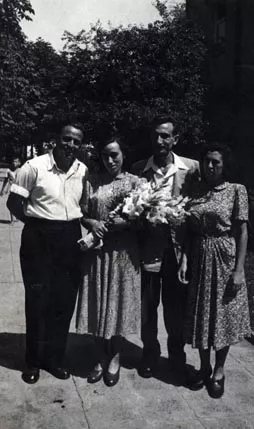This is a photo from my wedding. My wife Lora-Sofia and I are in the middle. Beside us are our sponsors Albert, first on the left, and Rashel Beraha, first on the right. The photo was taken on 17th August 1952 on Odrin Str in Sofia. Albert Beraha worked for a long time as supplier in Sofia and for the Interior Ministry.
In 1950 the Bulgarian government decided to establish the so-called 'Workers' Candidate Student School'. It was similar to the Russian 'Rabfak'. [Rafbak is an abbreviation for 'Rabotnicheski Fakultet' meaning Workers' Faculty. They were much popular in the 1970s and 1980s. They were organized with the cooperation of the Bulgarian Communist Party and their main goal was to prepare specialists to enroll in universities. The people were mostly from industrial companies. The courses lasted a number of months and people did not go to work while they were studying. The people sent to such courses had a good professional background and were recommended by the party representatives.] It was for workers who wanted to prepare to study at university. The goal was to educate a group of specialists who would be loyal to the authorities. I entered the school in 1950. For an year and a half I took all the high school subjects. I studied maths, history, literature and natural sciences, but I did not study music and painting. Then I entered in the Chemical Technological and Mineralogical Institute.
While I was studying at 'Rabfak', I met my wife Sofi. She was working as a printer and was also studying at 'Rabfak'. When we graduated, we became even closer friends. She entered the Higher Technological Institute and studied machine textile engineering. The studying was very hard for us because we were not prepared very well, but we focused our effort and managed to graduate. At that time, in 1952 we got married and went to live in the house of my parents. My degree is in selicate industry, although I was also working with the famous then inorganic technology. My fondness of glass directed me to selicate materials. When I graduated the institute, I started work in the Stind factory, where I had worked for a while before. By 1947 Stind had been a small factory in Orlandovtsi. There were other similar factories in Sofia - in Nadejda district, in Gorna Banya etc. After the nationalization in December 1947 all small factories were united under the name 'Stind'. I started work as an engineer in the factory in Gorna Banya. Later I also worked in the factory in Nadejda. Then I decided to apply for the post of a teacher in the technical high school on glass and fine ceramics. I taught analytical chemistry there for a year. In the end of 1959 I started work in 'Design Organization'. It changed its name and structures a lot through the years. It was also named 'Promproekt', 'Zavodproekt' etc. Nevertheless, from the beginning until my retirement in 1984 I worked on the design of glass factories.
I have two daughters - Rina Kohen and Jana Geron. Rina graduated the secondary polytechnical school in Sofia. She works in accounting. My other daughter Jana has a degree in statistics from the Economy Institute and works in the Statistics Institute. She is married to Mishel Geron and has two sons - Emil and Mihael.


















































